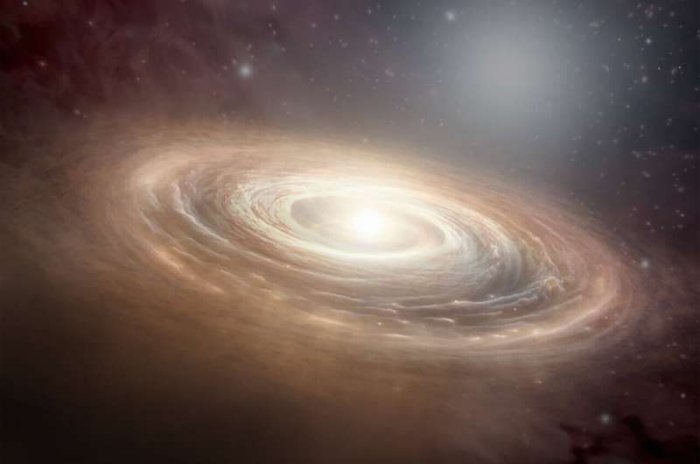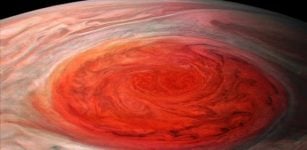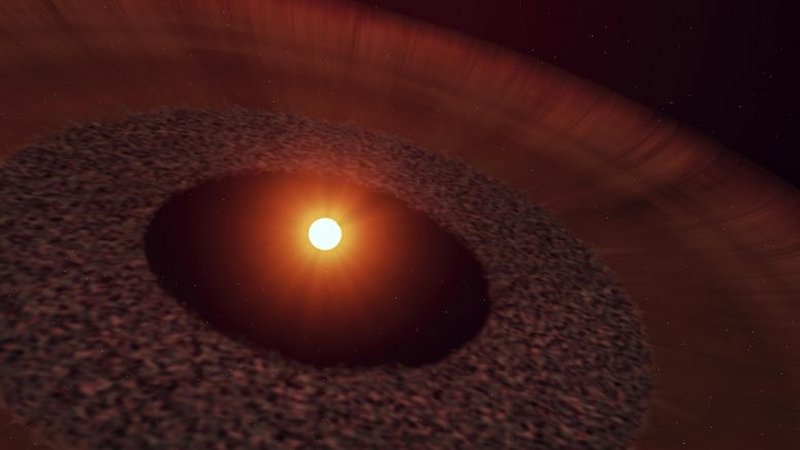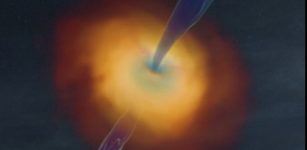Planet-Forming Disks Lose Gas Faster Than Dust, New Finds
Eddie Gonzales Jr. – MessageToEagle.com – Researchers at the University of Arizona Lunar and Planetary Laboratory has unveiled groundbreaking findings about the disks of gas and dust surrounding nearby young stars, using the powerful Atacama Large Millimeter/submillimeter Array, or ALMA.
Artist’s concept of a planet-forming disk, like the thirty studied for the ALMA AGE-PRO survey. The lifetime of the gas within the disk determines the timescale for planetary growth. Credit NSF/AUI/NSF NRAO/S.Dagnello
The findings are part of AGE-PRO, an ALMA program studying gas evolution in protoplanetary disks. As many as 30 planet-forming disks around sunlike stars were observed to measure gas disk mass at various ages. The study found that gas and dust components evolve at different rates.
Previous ALMA observations studied dust evolution in disks. AGE-PRO now traces gas evolution, offering the first measurements of gas disk masses and sizes throughout planet-forming disks, according to Ke Zhang of the University of Wisconsin-Madison.
“Now we have both, the gas and the dust,” said Ilaria Pascucci, a professor at planetary sciences at the U of A and one of three AGE-PRO co-principal investigators. “Observing the gas is much more difficult because it takes much more observing time, and that’s why we have to go for a large program like this one to obtain a statistically significant sample.”
A protoplanetary disk orbits its star for millions of years as gas and dust evolve, setting the stage for giant planet formation. The disk’s mass, size, and angular momentum influence the potential formation of planets—such as gas giants, icy giants, or mini-Neptunes—and their migration paths. The gas lifetime affects how quickly dust grows into asteroids, forms planets, and impacts their migration.
In one of the survey’s most surprising findings, the team discovered that as disks age, their gas and dust are consumed at different rates and undergo a shift in gas-to-dust mass ratio as the disks evolve: Unlike the dust, which tends to remain inside the disk over a longer time span, the gas disperses relatively quickly, then more slowly as the disk ages. In other words, planet-forming disks blow off more of their gas when they’re young.
Although most disks dissipate after a few million years, the ones that survive have more gas than expected. This would suggest that gaseous planets like Jupiter have less time to form than rocky planets.
ALMA’s unique sensitivity allowed researchers to use faint, so-called molecular lines to study the cold gas in these disks, characteristic wavelengths of a light spectrum that essentially act as “fingerprints,” identifying different species of gas molecules. The first large-scale chemical survey of its kind, AGE-PRO targeted 30 planet-forming disks in three star-forming regions, ranging from 1 million to 6 million years in age: Ophiuchus (youngest), Lupus (1-3 million years old), and Upper Scorpius (oldest).
Using ALMA, AGE-PRO obtained observations of key tracers of gas and dust masses in disks spanning crucial stages of their evolution, from their earliest formation to their eventual dispersal.
“Thanks to these new and long observations, we now have the ability to estimate and trace the gas masses, not only for the brightest and better studied disks in that region, but also the smaller and fainter ones,” Dingshan Deng, a graduate student at LPL and the lead author on one of the papers, said, adding that astronomers now have a well-studied sample covering a wide range of disk masses in the Lupus star-forming region.”
“It took years to figure out the proper data reduction approach and analysis to produce the images used in this paper for the gas masses and in many other papers of the collaboration,” Pascucci added.
Another sueprising finding was that the mass ratio between the gas and dust tends to be more consistent across disks of different masses than expected,, which means different-size disks will share a similar gas-to-dust mass ratio, whereas the literature suggested that smaller disks might shed their gas faster.”
Written by Eddie Gonzales Jr. – MessageToEagle.com Staff Writer











